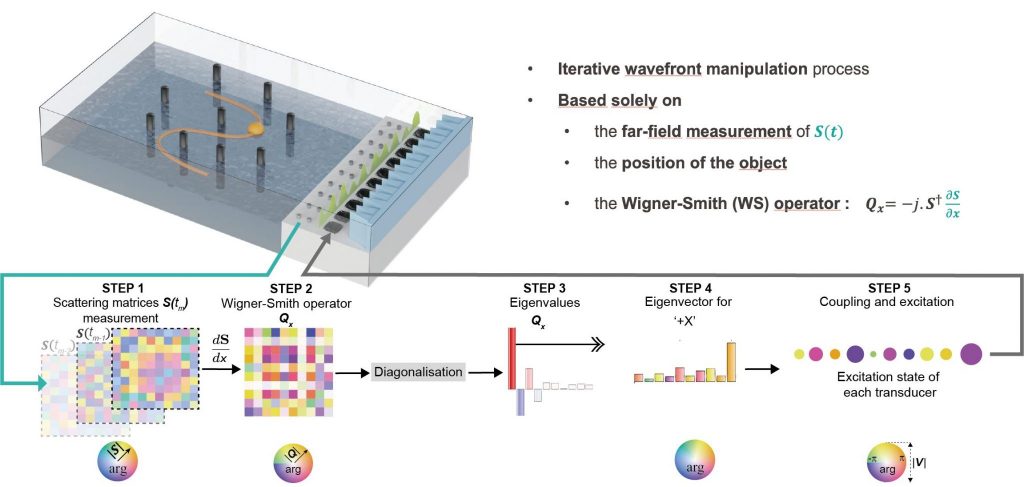Introduction
Since 2018 and the demonstration of the Nobel Prize-winning optical tweezers, waves have demonstrated their ability to create focalization spots and vortices in the wave field, which can be used to control and manipulate particles. Unlike optical tweezers, which require high power to trap any particle at risk of damage, their acoustic counterpart, acoustic tweezers, have been used to manipulate cells and fragile particles in the ultrasonic regime in a harmless manner. Although optical and acoustic tweezers have shown their potential for selectively manipulating particles and cells, they require in-depth knowledge of the object and the propagation medium, which must be low-reverberant (almost free space) and static.
At LWE, we developed a completely different strategy for manipulating objects with acoustic waves, based solely on the conservation of momentum and therefore requiring no prior knowledge of the propagation medium nor the object to be manipulated. Instead of forming a vortex to trap and manipulate objects, the idea we developed is to create a hot spot in the pressure field that iteratively pushes the element to the target location, as a hockey player pushes its puck. We call this technique wave-momentum shaping.
We ultimately succeeded in manipulating a spherical object, a ping-pong ball, at the surface of a water tank both in rotation and translation, with and without disorder, thanks to 20 loudspeakers positioned on either side of the tank.
How it works
The manipulation procedure combines two timely methods widely used in the physics of complex media, namely wavefront shaping and the Wigner-Smith operator, which allow us to determine the optimum mixture of modes to excite in order to push the object in the right direction. The method requires only real-time measurement of the scattering matrix and a position guide star (whether optical, magnetic or even acoustic) and can therefore also operate in a dynamic environment.

What we are working on
Now that we have demonstrated the feasibility of the protocol on a large-scale audible airborne acoustic system, we are concentrating on miniaturizing and optimizing the process. Several directions are favored:
- Unilateral excitation and transposition to the ultrasonic regime
- Use of the frequency degree of freedom to manipulate several particles in parallel
- Development of a lab-on-a-chip version for manipulating microscopic particles, micro-robots or cells under a microscope. Collaboration with biologists and specialists or micro-mechanical applications are welcome!
To learn more
- B. Orazbayev, M. Malléjac, N. Bachelard, S. Rotter and R. Fleury, “Wave momentum shaping for manipulating objects in heterogeneous and dynamic media“, Nature Physics, 2024.
- Emmanuel Fort, “Wavefronts wield tweezers amid disorder“, Nature Physics, 2024.
- Celia Lutherbacher, “Moving objects precisely with sound“, EPFL press release, 2024.
Involved LWE researchers
Tristan Nerson (PhD candidate)
Clément Férise (postdoc)
Collaborators
Matthieu Malléjac, Diego Baresch, University of Bordeaux (I2M)
Stefan Rotter, Technical University of Vienna
Bakhtiyar Orazbayev, Nazarbayev University
Open positions
We are looking for a Ph.D. student to join our team on this topic. See details here.
